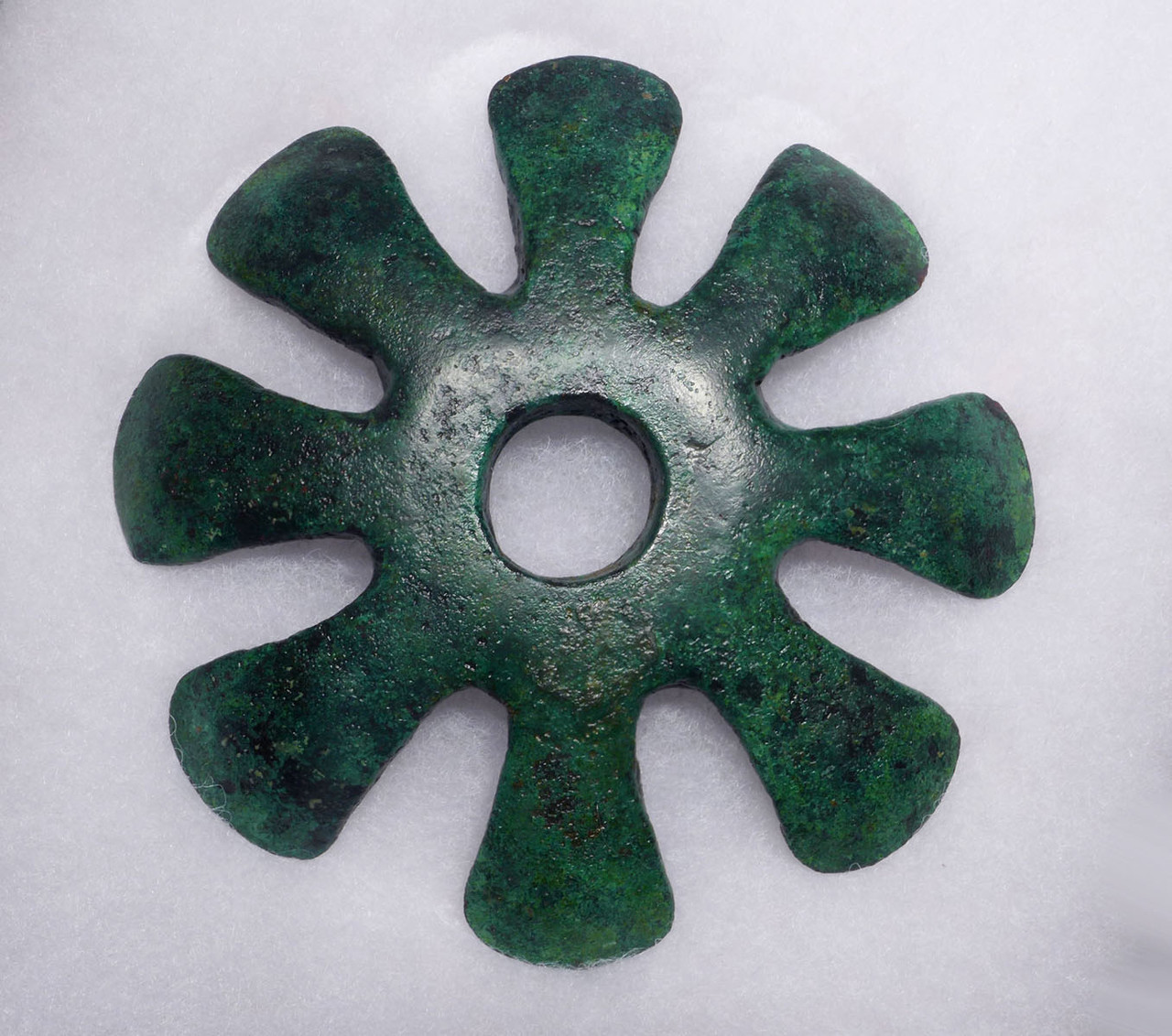Product Description
SEE MORE ANCIENT NEAR EASTERN ARTIFACTS
Without question, this is one of the rarest and most unusual ancient bronze mace heads we have ever offered in nearly three decades! It is a radial blade cutting mace in a huge flower petal form from ancient Bactria. Weapons from this enigmatic kingdom and region are incredibly rare and this is the ONLY time we have ever seen a weapon bearing this floral design. Belt buckles and stamps of this culture bear similar floral designs just like this mace head but incorporated into a weapon, this is a first! While the design looks aesthetic, its effectiveness would have been extreme, inflicting mortal wounds far beyond what any other mace head could have achieved. While most maces are designed to crush and injure by impact, this mace was designed to CUT. A few blows from this massive design and a enemy warrior could have easily been decapitated. The large diameter presented a broad cutting edge with each petal acting like an axe. This mace head is in the finest preservation with dramatic black, green and blue-green ancient colorful encrustations over the entire bronze surface.
The large center hole shows this would have been mounted to a robust wooden shaft handle. Unusual weapons of unique display are always meant as a show of rank and social class. Maces in themselves, were also a main weapon that were held in battle to signify rank and noble class. While the motif of this weapon is unique, similar floral designs are known from ancient Bactria such as an excavated wine goblet bearing a similar design on its entire underside. Nevertheless, this is form of this mace AND its actual function are extremely UNIQUE! Owning and wielding such an impressive and one-of-kind weapon would have been reserved for a warrior of equal uniqueness and status.
For a collector of ancient weapons , calling this a "Holy Grail" specimen is an understatement. In 32 years of working with ancient objects, we have never seen anything like this. it is an unusual combination of aesthetic and deadly effectiveness. From a day in ancient times when art and theatrics dominated ancient warfare.
This object has been professionally cleaned and conserved in our lab, being treated with a special sealer developed and formulated by us specifically for ancient metal preservation. The patina shows beautiful traits only found in authentic ancient weapons such as a layered mineralized patina with encrustations. No active bronze disease exists on its surfaces. Bronze disease can be a problem in bronze artifacts and untreated, it can literally eat away an artifact over a matter of years and turn the piece to powder.
WARNING: There is an increasing number of fake Near Eastern (Luristan) bronze weapons on the market. As fine quality intact, original specimens become more scarce and techniques have become more sophisticated to fake these weapons. We have personally handled numerous extremely well-done fakes with extremely convincing patinas. The degree to which the fakers have been able to replicate patina to disguise their work requires an expert examination by highly experienced individuals. It is common to find very reasonably priced weapons that are made up of part original and part modern components or wholly modern pieces displaying elaborate artificial patinas. All purchases should include from the dealer a written guarantee of authenticity with unconditional and lifetime return policies regarding such guarantee.
HISTORY
Bactria or Bactriana, was an ancient Iranian civilization in Central Asia centered on Northern Afghanistan or areas that comprises most of modern-day Afghanistan, and including parts of southwestern Tajikistan and southeastern Uzbekistan. To the south and east, it was bordered by the Hindu Kush Mountain range. On its western side, the region was bordered by the great Carmanian desert and to the north it was bound by the Oxus river.
Called "beautiful Bactria, crowned with flags" by the Avesta, the region is considered in Zoroastrianism to be one of the seventeen perfect Iranian lands that the supreme deity Ahura Mazda had created, and is one of the earliest centers of ancient Zoroastrianism. Bactria was the homeland of Indo-Iranians who moved south-west into Iran and the north-west of the South Asian subcontinent around 2500–2000 BC. It was in these regions, where the fertile soil of the mountainous country is surrounded by the Turan Depression, that the prophet Zoroaster was said to have been born and gained his first adherents. Avestan, the language of the oldest portions of the Zoroastrian Avesta, was one of the Old Iranian languages, and is the oldest attested member of the Eastern Iranian languages.
The main Bronze Age culture of the region dated from 2200 BC to 1700 BC is the Bactria–Margiana Archaeological Complex (BMAC) and also known as the "Oxus civilization". Several important trade routes from India and China (including the Silk Road) passed through Bactria and, as early as the Bronze Age, this had allowed the accumulation of vast amounts of wealth by the mostly nomadic population. The first proto-urban civilization in the area arose during the 2nd millennium BC. Control of these lucrative trade routes, however, attracted foreign interest, and in the 6th century BC the Bactrians were conquered by the Persians, and in the 4th century BC by Alexander the Great. These conquests marked the end of Bactrian independence. From around 304 BC the area formed part of the Seleucid Empire, and from around 250 BC it was the centre of a Greco-Bactrian kingdom, ruled by the descendants of Greeks who had settled there following the conquest of Alexander the Great.
 US DOLLAR
US DOLLAR
 EURO
EURO
 AUSTRALIAN DOLLAR
AUSTRALIAN DOLLAR
 CANADIAN DOLLAR
CANADIAN DOLLAR
 POUND STERLING
POUND STERLING




















